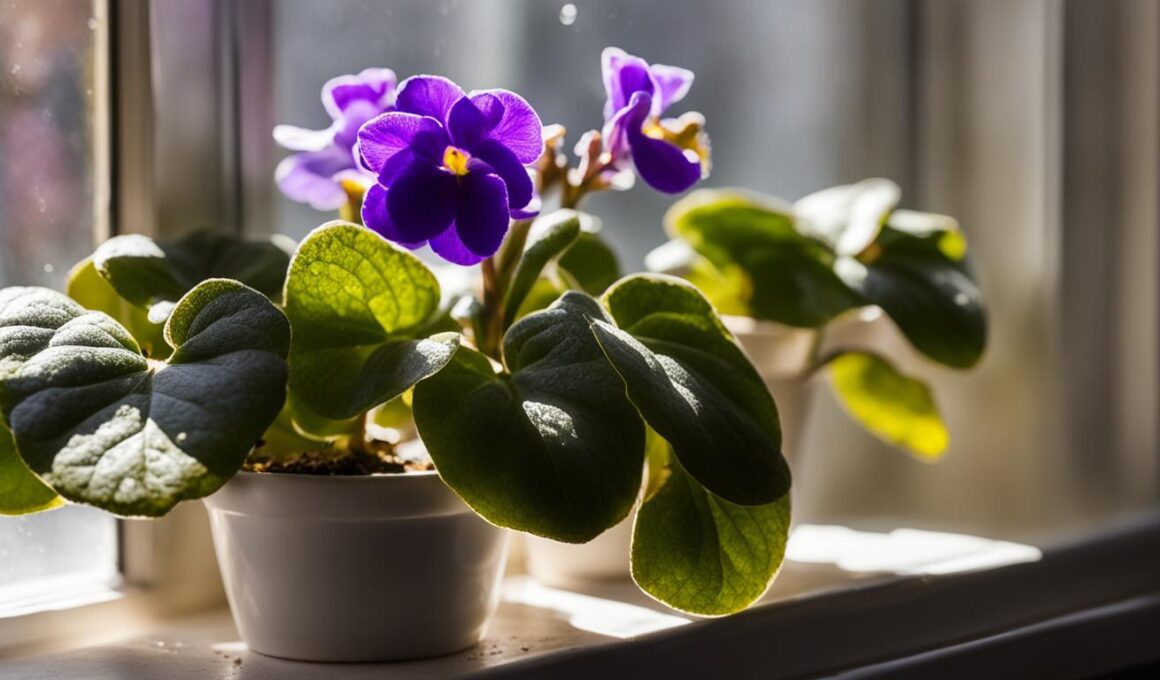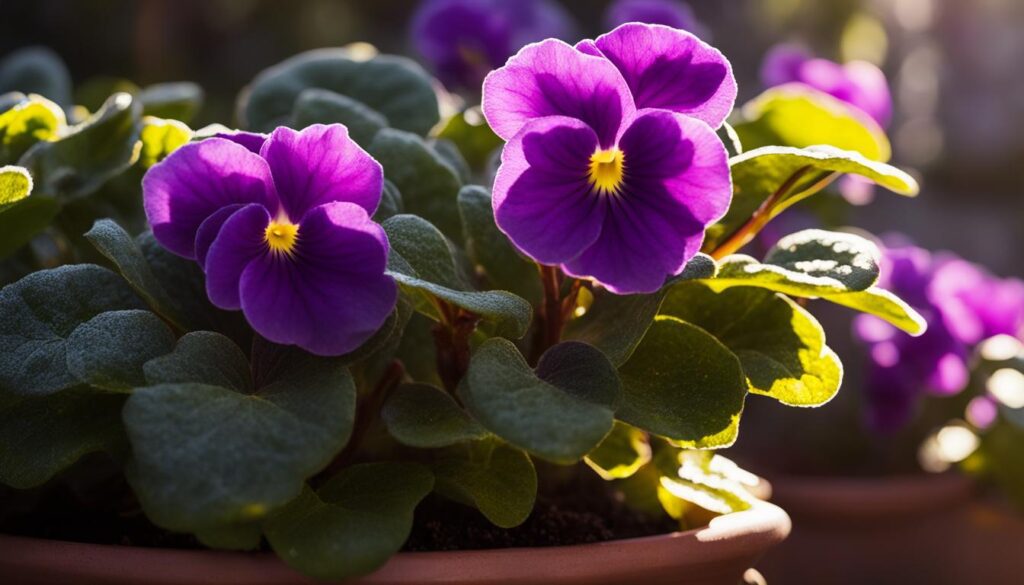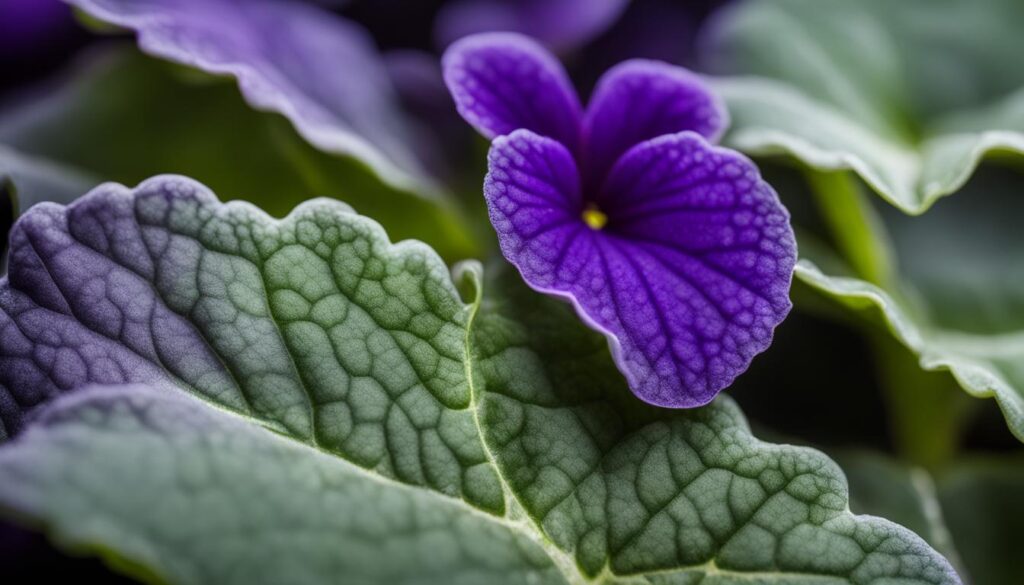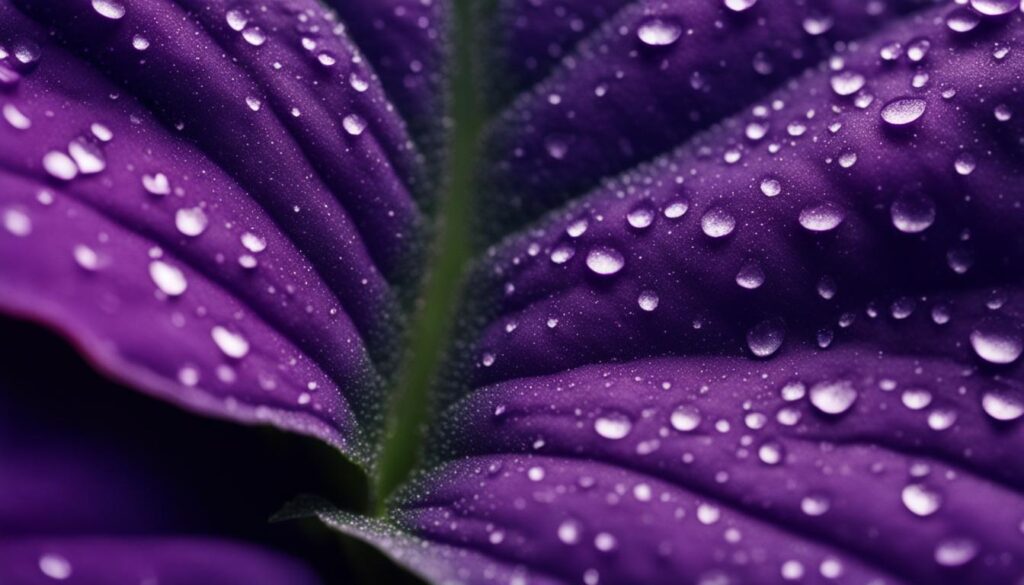Few houseplants brighten up indoor spaces quite like African Violets, with their captivating, violet blooms and lush green foliage. But when you notice your African Violet leaves turning yellow or suffering from other foliage problems, it can be concerning as these issues often indicate that the plant’s overall health is in jeopardy. In this guide, we’ll explore some of the most common reasons for yellow leaves in African Violets, as well as the steps you can take to remedy these problems and keep your beloved houseplants vibrant and healthy.
Key Takeaways
- Yellow leaves in African Violets can be a sign of various issues, including improper sunlight exposure, poor watering habits, nutrient deficiencies, and pests.
- Proper sunlight exposure is crucial for African Violet health and involves striking a balance between too much direct light (which can cause sunburn) and too little light (which can lead to leggy growth and reduced blooming).
- Watering your African Violets with room-temperature water, without wetting the leaves, and providing consistent moisture levels can prevent yellow leaves and other growth problems.
- African Violets require a specialized, well-balanced fertilizer to provide their specific nutrient needs and avoid deficiencies that can lead to yellow leaves.
- Proper soil quality, regular repotting, and pest control contribute significantly to maintaining optimal African Violet health and preventing yellow leaves and other foliage issues.
- Understanding the natural aging process of African Violets, which includes some yellowing of older leaves, can help you identify and address problems more accurately.
Introduction to African Violets and Yellowing Leaves
African Violets, known for their lush green foliage and bright blooms, make a beautiful addition to any indoor space. However, they require specific conditions to thrive. Yellowing leaves in these plants may indicate a need for change in growing conditions such as light, watering, or nutrients. While yellowing of lower, older leaves is part of their natural cycle, widespread yellowing should be investigated and addressed as soon as possible.
Recognizing some of the most common African violet problems can help you adjust your plant care routine accordingly. This section will provide an overview of the main causes for yellowing leaves, along with tips on how to prevent and treat them effectively.
- Improper Light Exposure
- Watering Issues
- Nutrient Deficiencies
- Pest Infestations
Understanding and addressing these issues can help restore the health of your African Violets, ensuring their vibrant foliage and blossoms thrive.
| Problem | Description | Solution |
|---|---|---|
| Improper Light Exposure | Too much direct sunlight can cause yellowing leaves and sunburn, while insufficient light can lead to yellowing and slow growth. | Ensure African Violets receive bright, indirect sunlight for around 8 to 16 hours per day. |
| Watering Issues | Excessive or insufficient watering can lead to yellowing leaves, root rot, and other problems. | Water consistently with room-temperature water, avoiding wetting leaves, and ensuring that the soil remains moist but not soggy. |
| Nutrient Deficiencies | Soil that is lacking in nutrients can cause yellowing leaves and reduced growth. | Use a balanced, African Violet-specific fertilizer to maintain healthy soil, and repot plants every few years with fresh soil mix. |
| Pest Infestations | Common pests like mealybugs, scale insects, and mites can cause yellowing leaves and poor plant health. | Inspect plants regularly for pests, isolate infected plants, and use a safe indoor plant insecticide to treat infestations. |
By monitoring and adjusting the light, water, and nutrient intake, as well as repotting with appropriate soil and controlling pests, you can prevent and remedy yellow leaves in your African Violets. Prompt action when problems are detected can help keep your plants vibrant and healthy.
Understanding the Impact of Sunlight on African Violets
African Violets need the right amount of sunlight to maintain their beautiful, lush foliage and vibrant blooms. Understanding the plant’s lighting requirements and adjusting the exposure accordingly can prevent yellow leaves and other issues related to sunlight exposure. In this section, we will cover the effect of sunlight on African Violets and how to maintain healthy foliage.
Too Much Sun: Recognizing Sunburn in African Violets
African violet sunburn occurs when the plant is exposed to an excess of direct sunlight, often resulting in direct sunlight damage on the leaves. Sunburnt African Violets will exhibit yellowed leaves that may develop brown spots, eventually leading to complete browning and leaf death. Direct sunlight, especially from south and west-facing windows, can cause this damage. Fortunately, sunburn can be mitigated by simply relocating the plant to a spot with less light intensity, like north or east-facing windows or by utilizing sheer curtains that diffuse the light.
Signs of Insufficient Light: When Your African Violet Needs More Sun
African Violet light requirements include 8-16 hours of bright indirect sunlight daily to thrive. Insufficient lighting symptoms manifest in various ways, such as yellowing leaves, leggy plant growth, poor plant development, and reduced blooming. To resolve these issues, move your African Violet to a brighter location with indirect sunlight, which can improve the plant’s overall health.
Adjusting Sun Exposure to Prevent Yellow Leaves
To prevent yellow leaves due to sunlight issues, ensure your African Violets receive the right amount of indirect light. Consider the following tips for optimizing light exposure:
- Place your African Violets near windows with optimal exposure, such as north and east-facing windows.
- Use sheer curtains to diffuse sunlight, filtering its intensity.
- Supplement natural light with grow lights to simulate the optimal lighting conditions African Violets require.
By adjusting the sunlight exposure in your African Violets’ environment, you can ensure healthy foliage and prevent the occurrence of yellow leaves.
Watering Practices for Healthy African Violets
To maintain your African Violets in peak health, proper watering techniques are essential. Understanding how to prevent water spots and provide optimal hydration is crucial, as improper watering practices can lead to yellowed leaves and damaged foliage. In this section, let’s explore suitable African violet watering techniques that help protect your beloved houseplants.
- Room Temperature Water: Always use room temperature water when watering African Violets, as cold or hot water may shock the plant, causing stress and yellow spots on the leaves.
- Direct Soil Watering: To avoid water spots on leaves from splashing, water the soil directly around the base of the plant. This technique protects the delicate foliage and encourages the roots to access water uniformly.
- Bottom Watering: Use a saucer or tray underneath the plant’s pot and fill it with room temperature water. This allows the plant to wick moisture upwards, ensuring proper hydration without wetting the leaves.
- Avoid Overhead Watering: Prevent water spots and reduce potential leaf damage by refraining from overhead watering. Overhead watering can cause water to accumulate on the plant’s surface and may lead to rot.
- Remove Excess Water: If water collects at the plant’s base due to overwatering or waterlogged conditions, promptly remove excess water by gently tilting the pot or using a clean cloth. This action prevents root rot and other issues caused by waterlogged soil.
In addition to the watering techniques listed above, understanding the frequency and volume of watering can further improve the health of your African Violets.
| Watering Frequency | Typically, African Violets require watering once a week, but be sure to adjust the frequency according to factors such as humidity, temperature, and size of the pot. |
|---|---|
| Watering Volume | The amount of water needed for each watering session might differ depending on factors such as plant size and weather conditions. Aim to water just enough to ensure the soil remains moist, but not soggy. |
| Signs of Overwatering | If your African Violet exhibits symptoms such as yellowing leaves, wilting, or a musty smell, it could be suffering from too much water. Adjust your watering practices accordingly to address any deficiencies identified. |
| Signs of Underwatering | Dry soil, wrinkled leaves, and reduced blooming are signs that your African Violets require more water. To rectify this issue, increase your watering frequency and monitor the plant closely for improvements. |
By employing proper African violet watering techniques, you can prevent water spots and ensure optimal hydration for your houseplants, ultimately promoting their overall health and vigor.
The Nutritional Needs of African Violets
African Violets, like all plants, require essential nutrients to grow and thrive. These nutrients play an integral role in promoting their overall leaf health and preventing premature yellowing. A well-balanced fertilizer and regular care can prevent nutrient deficiency yellow leaves and promote healthy growth.
Choosing the Right Fertilizer
The key to achieving optimal African Violet health is using a species-specific African violet fertilizer with a balanced NPK (Nitrogen, Phosphorus, and Potassium) ratio. These plant-specific nutrients will provide the exact nourishment they need for optimal growth. It is essential to follow the manufacturer’s directions when applying the fertilizer, usually drenching the soil every three months.
An African Violet fertilizer with a balanced NPK ratio will usually contain equal parts Nitrogen, Phosphorus, and Potassium. Nitrogen supports leaf growth, while Phosphorus aids in root development and bloom production, and Potassium promotes overall health.
Identifying Nutrient Deficiencies by Leaf Color
Besides over- or under-fertilization, specific nutrient deficiencies can also cause the leaves of your African Violet to yellow. Here are some common nutrient deficiencies and their leaf color symptoms:
| Nutrient | Leaf Color Symptom |
|---|---|
| Magnesium | Yellowing around the edges or between the veins |
| Iron | Yellowing between the veins, with green veins remaining |
| Zinc | Yellowing along the veins |
To counter these nutrient deficiencies, replace the soil and apply the proper African violet fertilizer. This will correct the imbalance, restoring health to the plant and preventing further yellowing. Keep in mind that regularly repotting and applying the right fertilizer is essential to avoid nutrient deficiencies and maintain good African violet leaf health.
Soil Quality and Repotting: Refreshing Your African Violet’s Home
Healthy, nutrient-rich soil is essential for African violets to thrive. If you notice your African violet showing signs of stress such as yellow leaves or poor overall health, it may be time to consider repotting. This process refreshes the soil and can help revive a struggling plant.
How to Tell When It’s Time to Repot
Typical African violet repotting signs include:
- Yellowing or wilting leaves
- Roots visible at the soil surface or growing out of the drainage holes
- Stunted growth or diminished blooming
- Soil erosion or compaction
These issues can be the result of root-bound conditions, where roots have filled the pot and have nowhere to grow. Soil quality may also degrade over time, losing its structure and nutrient content. When you spot these signs, it’s time for a soil refreshment.
Choosing the Right Soil Mix for Optimal Health
Using the proper African violet soil mix is crucial for ensuring their health and longevity. African violets thrive in a light well-draining soil with acidic pH levels between 5.8 and 6.2. This type of soil allows roots to access air, water, and nutrients effectively.
When choosing a soil mix for your African violet, consider the following:
- Opt for a high-quality, commercial African violet mix, or
- Make a homemade blend using a specific recipe tailored for African violets (e.g., a mix of peat moss, vermiculite, and perlite)
| Ingredients | Benefits |
|---|---|
| Peat moss | Retains moisture and helps maintain the desired acidic pH |
| Vermiculite | Improves soil aeration, promotes root growth and prevents compaction |
| Perlite | Increases drainage and air circulation |
By using a suitable soil mix while repotting your African violet, you can provide the optimal conditions your plant needs to grow healthy and vibrant. Regularly monitoring your plant’s health and repotting as needed can keep the leaves green, the blooms abundant, and your African violet thriving for years to come.
Tackling Common Pests That Affect African Violets
African violets are susceptible to a variety of pests that can damage their leaves and overall health. Some common African violet pests include mealybugs, scales, mites, and aphids. These pests can cause the leaves to yellow, curl, or become deformed, negatively affecting the look and health of your beloved houseplants. To protect your African violets and maintain their vibrancy, it’s crucial to identify and control these pests early on.
Steps to Control African Violet Pests
- Identify the pest: Mealybugs appear as small, white, cottony masses, while scales look like brown or black bumps on the leaves or stems. Mites are tiny and not easily seen, but their presence can cause leaves to become speckled and discolored. Aphids are small, soft-bodied insects that tend to cluster on new growth and buds.
- Isolate the affected plants: To prevent the pests from spreading to your other houseplants, isolate the affected African violets in a separate area.
- Treat the infestation: You can remove a small number of pests by hand or by using a cotton swab dipped in alcohol. For more severe infestations, consider using a safe indoor plant insecticide according to the manufacturer’s directions.
- Monitor progress: Keep an eye on the treated plants to ensure the pests do not return, and promptly treat any recurring infestations.
Caring for your African violets means being attentive to potential pest control issues. By knowing the signs of common pests and acting quickly to treat infestations, you can maintain the health and beauty of your plants. Remain vigilant in watching for and addressing mealybugs, scales, and other pests to ensure your African violets continue to thrive.
Natural Aging Process: Expecting and Managing Yellow Leaves
Understanding the African violet aging process is crucial in maintaining the overall health and appearance of your plant. The lifecycle of leaves in African Violets involves a natural yellowing and eventual browning of the older leaves at the base of the plant, making way for new growth. This is an entirely normal process that usually occurs after the first year of growth and should not be a cause for concern.
It is essential to differentiate this natural aging process from other yellowing causes, such as insufficient light or overwatering. Yellowing leaves due to the aging process are typically limited to the oldest leaves at the base of the plant. If you notice yellow leaves progressing upwards or throughout the plant, it may be an indication that your African Violet is experiencing other health issues.
When managing natural yellowing due to the aging process, consider these steps:
- Regular inspection: Monitor your plant closely for any changes in the condition of the leaves, particularly at the base of the plant.
- Leaf removal: Gently remove any old yellowed or brown leaves to maintain the plant’s appearance and encourage healthy growth.
- Pest control: Regularly check for any signs of pests such as mealybugs or mites, as older leaves are more susceptible to infestation.
By staying proactive and consistently tending to the natural aging process, you can ensure your African Violet remains a beautiful, healthy addition to your indoor space.
Could the Yellowing of African Violet Leaves be Related to Sunlight Exposure?
When caring for African violets, understanding their sunlight needs is crucial. If the leaves start yellowing, it could be due to excessive sunlight exposure. These delicate plants thrive in bright, indirect light, so finding the right balance is key. Adjust their placement to ensure they get the ideal amount of sunlight.
Conclusion: Keeping Your African Violets Vibrant and Healthy
African violet maintenance is essential for keeping these charming houseplants thriving with lush foliage and beautiful blooms. By optimizing plant care, you can prevent yellow leaves and ensure your African Violets remain vibrant and healthy. Regular observation and prompt attention to any issues can help your plants flourish, transforming your indoor space into a lush, colorful haven.
Effective care for African Violets involves adjusting light exposure, refining watering practices, and fulfilling their nutritional needs with proper fertilization. Additionally, maintaining high-quality soil, managing pests, and understanding the natural aging process of these delicate plants can help prevent many foliage problems. A well-tended African Violet will reward you with stunning blooms and lush greenery, making it a valued addition to your indoor environment.
Becoming familiar with your African Violets’ specific requirements and proactively addressing their needs will enable these lovely houseplants to thrive for years to come. As you gain experience in caring for these beautiful plants, you’ll be rewarded with their delightful blossoms and verdant foliage, enhancing the visual appeal and charm of your home.












